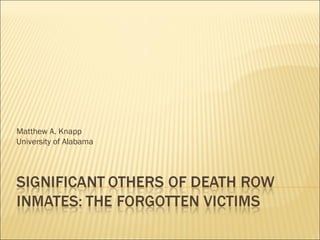
Significant others of death row inmates
- 1. Matthew A. Knapp University of Alabama
- 2. STUDIES ON THOSE WHO HAVE HAD A FAMILY MEMBER DIE BY HOMICIDE STUDIES ON THOSE WHO ARE SIGNIFICANT OTHERS OF A HOMICIDE PERPETRATOR Qualitative : experiences of survivors (2) Theory (5) Therapeutic Interventions (3) Service Provision (3) Victim Impact Statements (2) Qualitative (experiences of survivors) (5)
- 3. Have skyrocketed since the early 1980’s Victim/Witness Protection Act of 1982 Allows for Victim Impact Statement prior to sentencing State and federal programs set up for referral, counseling, and financial support Numerous human service agencies assist victims (e.g. San Diego) Co-victims may begin or join support groups (e.g. Parents of Murdered Children)
- 4. May start/attend self help groups Private counseling Going to conferences Prison support (rare), involving funeral arrangements, distribution of possessions, and follow-up from professionals after execution Religiosity
- 5. Sleeplessness Guilt Anxiety Fear Being ostracized from their community No opportunity to provide an Impact Statement prior to sentencing Possible loss/decrease in income Stress due to media exposure Isolation Increased stress in dealing with the perpetrator over time Prolonged, complicated grief (knowing the family member will die, postponement due to appeals draws out process Relationship problems in the family unit
- 6. Foucault and the “Panopticon” Shift from punishment of the body to control of the mind Treatment of perpetrator families may be less about overt actions, more about the covert Denial or lack of existing formal services might = covert control Others in the community acting as “guards” between victim and perpetrators families Community as Panopticon- discouraging families of perpetrators from full participation in community
- 7. Goffman The Stigmatized Body Perpetrators families attempting to “pass” Being “found out” reinforces negative self-image Stress of “secret keeping”
- 8. FAMILIES OF VICTIMS: FAMILIES OF PERPETRATORS: Feel the homicide was senseless Have profound alteration of world view Seek justice through legal system Rarely meet or speak with perpetrators family Understand why their family member received death sentence-accept it Have less alteration of world view Often want to speak with and apologize to victim’s family
- 9. Experience feelings of guilt Feel shock and horror Anger Experience relationship problems in family unit Are stressed by media attention Report issues with Law Enforcement (manner of death notification, and perceptions of “guilt by association”)
- 10. Allowing a form of VIS from the family of the perpetrator prior to sentencing Using professionals who can work with both “sides” (families) to facilitate communication between them Providing a separate space for perpetrator’s family to regroup during trial and sentencing Providing for emotional and mental health concerns before, during and after trial and sentencing Increased implementation of Social/Restorative Justice options
- 11. Both victims and perpetrator families have many overlapping issues and experiences Literature on perpetrator’s family’s experiences was strong in the 1970’s, disappeared after the Victim/Witness Protection Act in 1982, and now is coming back in the past few years Supports within a community differ dramatically Each “body” (of victim and perpetrator) is forever tied to the respective families, maintaining social status distinctions Witnessing an execution did little to provide closure to families of homicide victims How homicide is viewed and addressed is a societal issue, rather than simply an individual issue
Notas del editor
- <number>
- This is based on a non-exhaustive literature review for the assignment